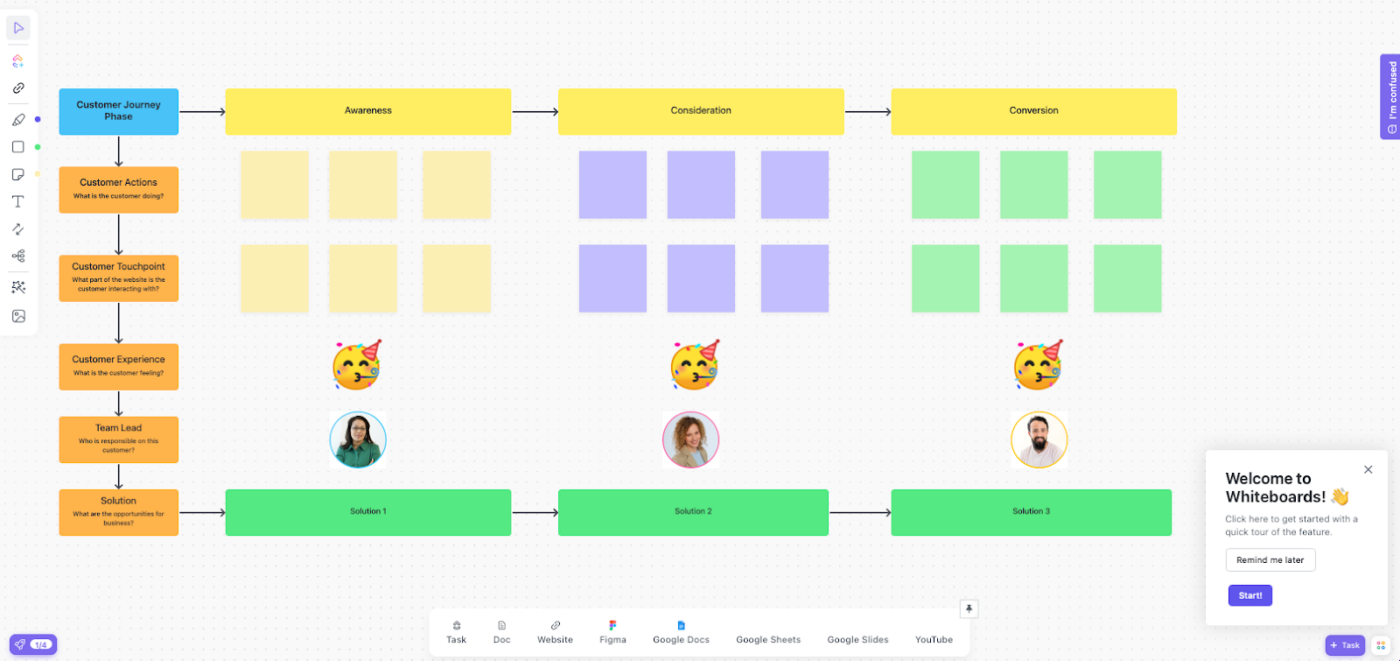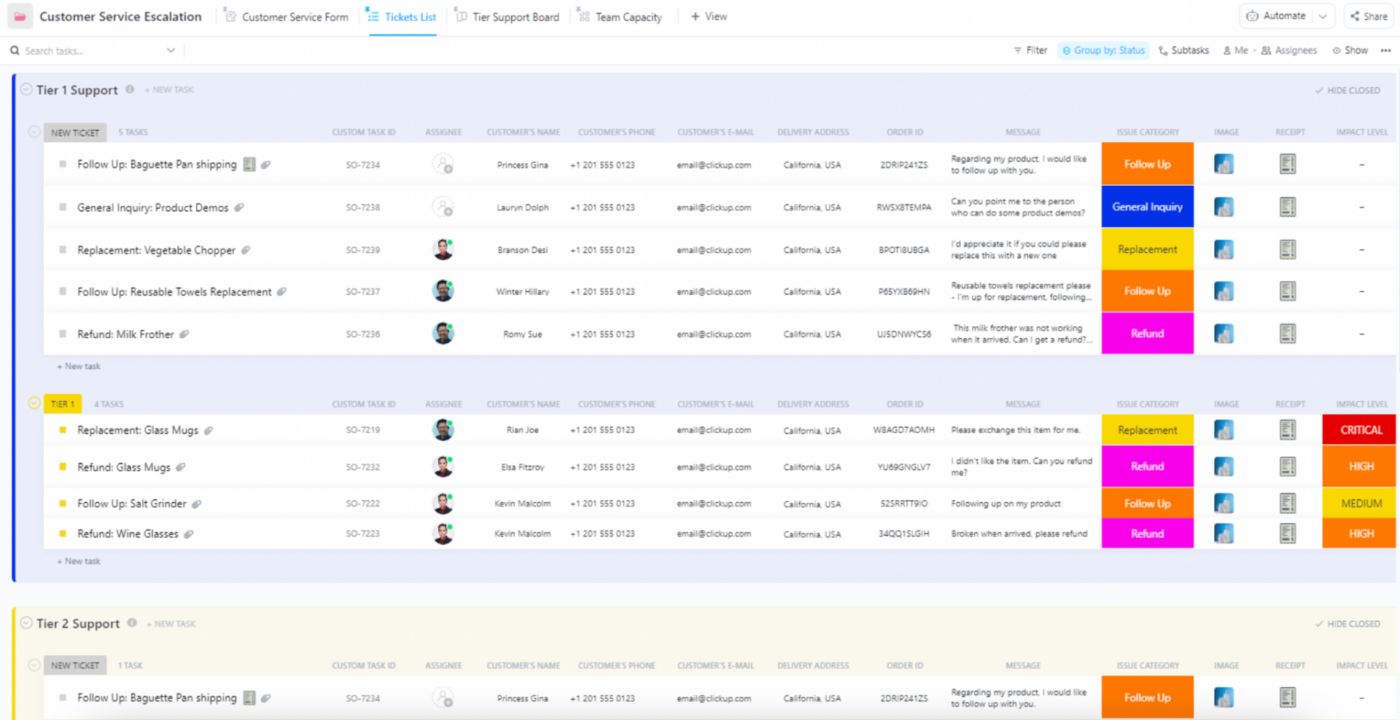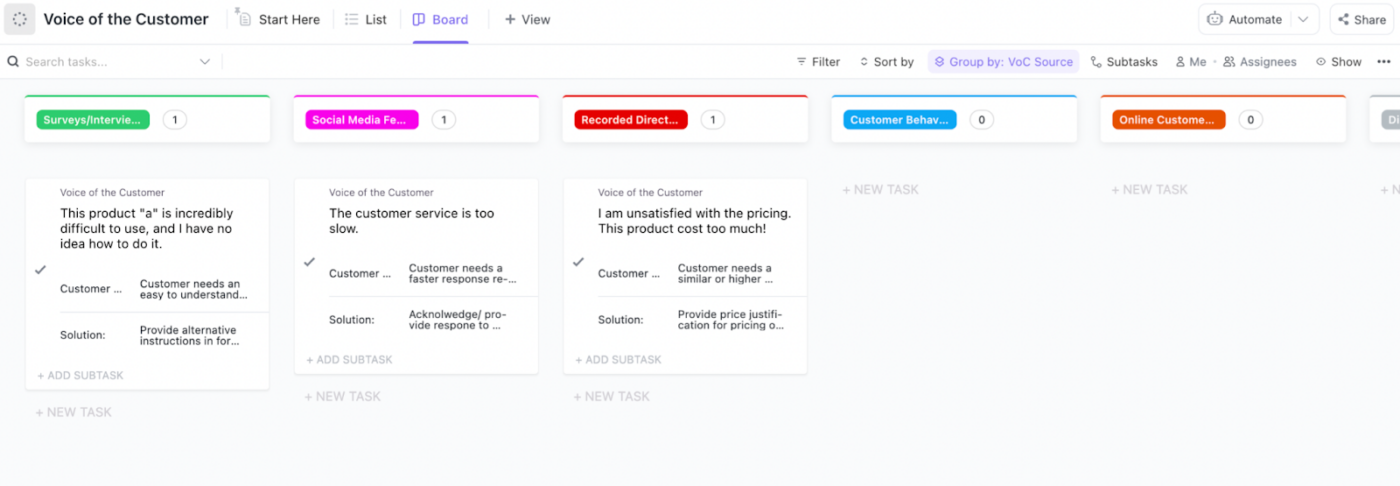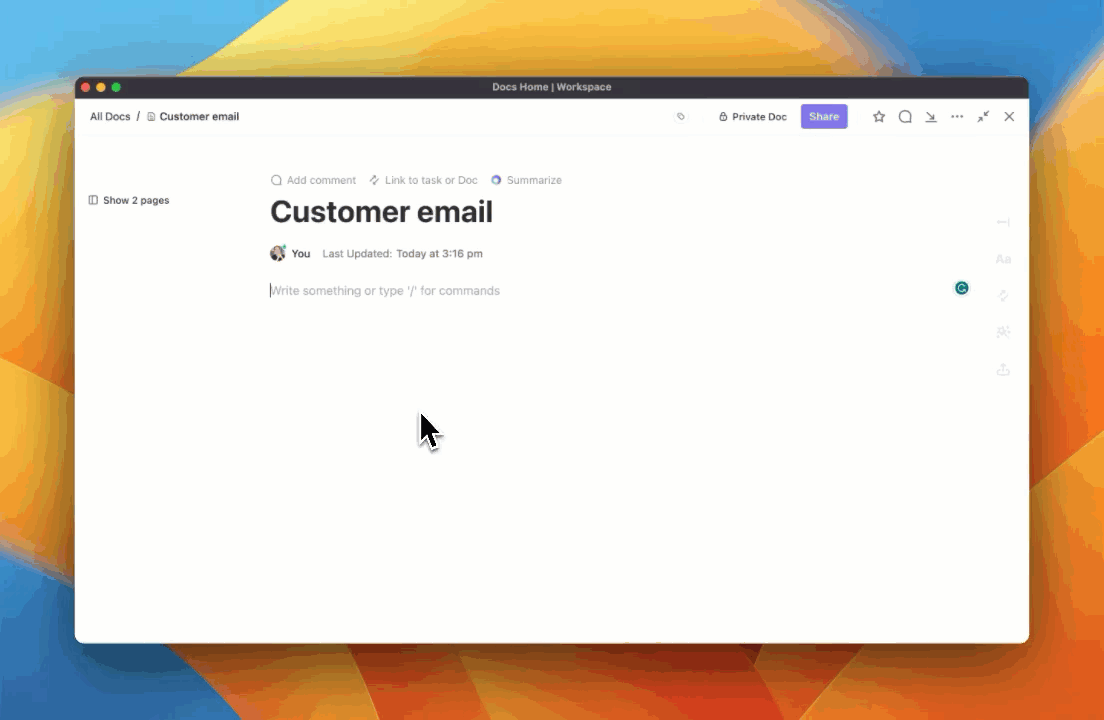كيف تحدد العلامات التجارية القيمة الحقيقية لعملائها؟
يعد النظر إلى رحلة العميل بأكملها - بدءاً من الاتصال الأولي وحتى الدعم بعد الشراء - بداية جيدة.
يتتبع مسوقو دورة الحياة تفاعلات المستخدمين، ويحللون البيانات لفهم أنماط سلوك العملاء، ويحددون القيمة بناءً على عوامل مثل تكرار الشراء، ومتوسط قيمة الطلب، وقيمة عمر العميل، وقياس نجاح هذه المقاييس.
تساعد هذه الجهود في تقسيم قاعدة العملاء بشكل دقيق، وتخصيص جهود التسويق لمجموعات محددة، وتخصيص الموارد على النحو الأمثل.
نظرًا لأن جميع العملاء لا يتناسبون مع نفس القالب من الاحتياجات والتفضيلات والسلوكيات، فمن الآمن افتراض أن كل عميل فريد من نوعه.
يشكل إدراك واحترام هذه الاختلافات بين العملاء أساس التسويق الناجح لدورة الحياة.
استخدم هذا الدليل لإثراء جهودك في تسويق دورة حياة العميل وإشراك العملاء بشكل هادف.
ما هو تسويق دورة حياة العميل؟
التسويق عبر دورة حياة العميل هو ممارسة تخصيص التواصل مع العملاء على أساس مرحلة رحلة العميل مع علامته التجارية.
يستفيد هذا النهج رفيع المستوى من مزيج من استراتيجيات التسويق لتقديم أعلى قيمة للعملاء في كل مرحلة من مراحل دورة حياة العميل.
كلما اكتسب العملاء قيمة أكبر من علامتك التجارية، تتحول عمليات الشراء لمرة واحدة إلى ولاء العملاء مدى الحياة على المدى الطويل.
وفي الوقت نفسه، تستفيد العلامات التجارية من مشاركة العملاء بشكل أفضل وزيادة تحقيق الدخل مع مرور الوقت.
فوائد تسويق دورة حياة العميل ## فوائد تسويق دورة حياة العميل
من الشائع التساؤل: ما هي الفوائد التي يحصل عليها العملاء إذا قامت العلامة التجارية بالتسويق لكل منهم بشكل مختلف؟
يتخذ التسويق الفعال لدورة حياة العميل نهجًا مجزأً يركز على العميل أولاً للجمهور المستهدف، مما يساعد المستخدمين النهائيين على التواصل مع العلامة التجارية.
وبفضل الارتباط الأعمق، تحصل العلامات التجارية على الثقة لبناء علاقات أقوى ومفيدة للطرفين مع العملاء الحاليين والمستقبليين وخلق المزيد من القيمة:
وقد أظهرت الأبحاث أن الشركات التي تقدم تجربة عملاء أفضل بكثير من نظيراتها تحقق ولاء عملاء أعلى بنسبة 70% وتحقيق نمو في الإيرادات بنسبة 190% أعلى من المؤسسات النظيرة.
عندما يكتسب العملاء انجذابًا لعلامتك التجارية، يصبح (بقاءهم) لفترة أطول حقيقة واقعة (مما يؤدي إلى تحسين الاحتفاظ بالعملاء!).
6 مراحل تسويق دورة حياة العميل ## 6 مراحل تسويق دورة حياة العميل
يكون التسويق المؤثر لدورة حياة العميل ممكنًا عندما يكون لديك فهم عميق للمراحل المختلفة لدورة حياة العميل لمنتجك أو خدماتك.
يتخذ العملاء مسارات مختلفة عند التفاعل مع عملك التجاري. ويصبح كل مسار هو "رحلتهم" مع العلامة التجارية:

قالب خريطة رحلة العميل في ClickUp
دورة حياة العميل هي عملية طويلة الأمد. فهي تبدأ بتعرف العملاء المحتملين على علامتك التجارية وتنتهي بتحولهم إلى مناصرين للعلامة التجارية
تغطي رحلة العميل النموذجية ست مراحل: الاكتشاف (أو الوصول)، والاكتساب، والاكتساب، والتحويل، والاحتفاظ، والولاء، والدعم.
تتميز كل مرحلة بخصائص دقيقة، وبالتالي تتطلب نهجًا فريدًا.
بالإضافة إلى ذلك، قد تجد العملاء ينتقلون عدة مرات خلال المراحل الست مع تطور علاقتك معهم.
دعنا نستعرض هذه المراحل المختلفة واحدة تلو الأخرى.
المرحلة 1: الاكتشاف
تتعلق المرحلة الأولى، الاكتشاف (وتسمى أيضًا الوصول أحيانًا)، بالوصول إلى العملاء المحتملين عندما يكونون في وضع التأمل.
قد يعثر عليك العملاء المحتملون عند البحث عن منتج ما عبر الإنترنت أو من خلال التوصيات الشفوية الإيجابية.
قد تكون هذه هي المرة الأولى التي يسمع فيها العميل المستقبلي بعلامتك التجارية. لذلك، استفد من هذه الفرصة لمساعدتهم في التعرف على علامتك التجارية أو منتجك.
استخدم هذه النصائح للوصول إلى العملاء في وقت مبكر من عملية التقييم:
- استفد من وسائل التواصل الاجتماعي، وتحسين محركات البحث (SEO)، والتسويق الرقمي، وغير ذلك من الوسائل الأخرى للوصول إلى العملاء المحتملين - كن حاضرًا على القنوات التي يترددون عليها
- ركز على بناء علاقة بين احتياجات العميل والمنتج من خلال رسالتك التسويقية
- قم بواجبك لمعرفة ما يفعله المنافسون واقرأ آراء العملاء لسد فجوة "التوقعات
- قم بالتسويق بطريقة تجذبهم مرة أخرى - سواء للحصول على المزيد من المعلومات أو لتثقيفهم حول العلامة التجارية
المرحلة 2: الاستحواذ
تتعلق عملية الاستحواذ بإدخال العملاء إلى قاعدة بياناتك - بغض النظر عن قناة الاستحواذ التي يستخدمونها للوصول إليك، مثل الهاتف أو المتجر الفعلي أو الموقع الإلكتروني أو وسائل التواصل الاجتماعي وغيرها.
على سبيل المثال، قد يزور العميل المحتمل متجرك في مدينته. في هذا السيناريو، يجب على فريقك:
- قضاء بعض الوقت معهم والرد على استفساراتهم
- محاولة فهم احتياجاته ودوافعه بعمق
- تقديم اقتراحات مخصصة بناءً على احتياجاتهم
- تثقيفهم حول المنتج/الخدمة الموصى بها
- اطلب معلومات الاتصال الخاصة بهم واعرض عليهم مشاركة المزيد من التفاصيل أو إجراء مكالمة متابعة
في مناسبات أخرى، إذا تواصل معك عميلك المحتمل على الموقع الإلكتروني، يجب عليك
- تقديم محتوى مفيد وتعليمي وقيّم
- اقتراح عروض محتوى مخصص
- إعادة توجيه العميل إلى صفحة التسعير
- الترويج لمدونات هادفة ومنسقة من قبل الخبراء
- تقديم خيار الدردشة لمناقشة متطلباتهم بشكل أكبر
لتوطيد علاقتك بشكل أكبر مع العميل المحتمل:
- اعتمد على ما يعرفه عميلك بالفعل عن علامتك التجارية
- تحفيزهم على الانخراط في خطوات المتابعة مثل طلب عرض توضيحي للمنتج، والتحدث مع مندوب المبيعات حول خصومات الأسعار، وما إلى ذلك
- درّب متخصصي المبيعات وخدمة العملاء لديك على ترك انطباع دائم لدى العميل المحتمل من خلال تقديم إجابات مستنيرة وحل سريع للاستفسارات
- عرض محتوى قيّم (على سبيل المثال، الآلات الحاسبة وقوائم المراجعة والأدلة المتعلقة بمشكلتهم، وما إلى ذلك) مقابل معلوماتهم
- تتبّع جميع استفسارات وطلبات العملاء في مكان واحد، بحيث لا يفوتك أي شيء

_قالب ترقية خدمة العملاء من خلال النقر فوق قالب ترقية خدمة العملاء يرتقي بمهارات فريقك في إدارة الاستفسارات
المرحلة 3: التحويل
المرحلة الثالثة، التحويل، وتسمى أحيانًا مرحلة الشراء. في هذه المرحلة من دورة حياة العميل يكون العميل على دراية بعلامتك التجارية ومنتجاتك. ويكون قد شكّل قائمة مختصرة بالعلامات التجارية أو المنتجات المحتملة لمتطلباته الخاصة، وأنت ضمنها.
إنهم سعداء بتجربة العميل ومستعدون للشراء.
لتحقيق أقصى استفادة من مرحلة التحويل:
- حدد بوضوح القيمة التي تقدمها
- اعرض المزايا الرئيسية لعروضك مقارنةً بعروض المنافسين
- تطبيق ما تعلمته عن رغبات العميل واحتياجاته وأولوياته في حملاتك التسويقية
- تنفيذ تجربة شراء سلسة
المرحلة 4: الاحتفاظ بالعملاء
واحدة من أصعب المراحل في دورة حياة العميل، وهي مرحلة الاحتفاظ بالعملاء، وهي مرحلة الاحتفاظ بالعملاء.
وغالبًا ما يتعين على المسوقين التفكير في عشر خطوات إلى الأمام للحفاظ على عودة العملاء مرة أخرى.
لإنشاء قاعدة ثابتة من العملاء المتكررين:
- احرص على أن تكون خدمة العملاء استباقية وليست تفاعلية
- تتبّع بانتظام آراء العملاء حول منتجك وخدمة العملاء
- تأكد من حصول العملاء على أقصى استفادة ممكنة من منتجك/خدمتك
- اجمع آراء العملاء في الوقت الفعلي لفهم ما الذي ينجح مع عملائك (وما لا ينجح) من خلال استطلاعات الرأي والاستطلاعات والمقابلات والفعاليات والمسابقات وغيرها

نقر فوق قالب صوت العميل لالتقاط إحباطات العملاء بدقة
- تقديم تجارب فائقة التخصيص تعكس تفضيلات عملائك وتعزز علاقتك بهم
- قياس درجة رضا العملاء وإجراء التحسينات اللازمة للبقاء في المقدمة
- قم بتنظيم مكافآت مخصصة للعملاء وتقديم عروض منتجات مغرية ودعم على مدار الساعة ومكافآت الإحالة وما إلى ذلك، لتوجيه العملاء للمرحلة الخامسة
الفكرة هي تحويل تقارب العلامة التجارية إلى حب، وبالتالي الوصول إلى مرحلة الولاء من دورة حياة العميل.
المرحلة 5: الولاء
لا ينتهي عملك باكتساب العملاء والاحتفاظ بهم لعلامتك التجارية. يجب عليك أيضًا أن تضمن أن يظل عملاؤك سعداء وأن يفكروا في شرائك في المستقبل.
إن مرحلة الولاء أمر بالغ الأهمية؛ فهذه هي فرصتك لتحويل العميل من مشترٍ لمرة واحدة إلى مشترٍ متكرر.
ولإبقاء العميل سعيدًا بعد الشراء، يجب أن يتطلع المسوقون إلى بناء علاقة معه.
- أرسل لهم محتوى عالي الجودة ومفيد
- شجّعهم على متابعة علامتك التجارية على وسائل التواصل الاجتماعي والاشتراك في رسالتك الإخبارية
- مشاركة تحديثات منتظمة معهم حول الميزات أو العروض الجديدة، مما يضمن بقاءك في صدارة اهتماماتهم
- عامِلهم كصديق قيّم وعبّر لهم عن امتنانك لدعمهم
- اطلب ملاحظاتهم وتصرف بناءً على اقتراحاتهم للتحسين
المرحلة 6: المناصرة
بمجرد أن يطور عملاؤك ولاءهم تجاه علامتك التجارية، يجب أن يكون جهدك الأخير معهم هو تحويلهم إلى مناصرين للعلامة التجارية.
يمكن للعملاء الذين يعتبرون مناصرين مخلصين لعلامتك التجارية أن يوفروا لك تسويقًا شفهيًا قيّمًا. بالإضافة إلى ذلك، من المرجح أن يشتري هذا القسم من العملاء المزيد من منتجاتك دون حافز وينفقون أكثر معك بمرور الوقت. علاوة على ذلك، يمكنهم تقديم ملاحظات ومدخلات قيّمة حول تحسين منتجاتك الحالية أو تصميم منتجات جديدة.
في هذه المرحلة، يجب أن يهدف التسويق خلال دورة الحياة إلى:
- تشجيع العملاء على مشاركة آرائهم الإيجابية على وسائل التواصل الاجتماعي وأماكن أخرى
- تقديم عضوية لهم في برامج الولاء والمجتمع وبرامج الإحالة بمزايا خاصة
- إطلاق برنامج انتساب للمستخدمين المتميزين
- إظهار تقدير هؤلاء العملاء لهؤلاء العملاء، من خلال العروض الخاصة والفعاليات وما إلى ذلك.
رسم خريطة لدورة حياة العميل لاتخاذ قرارات تسويقية مستنيرة مدعومة بالبيانات وأولويات العملاء والعلامة التجارية أهداف التسويق .
الاستراتيجيات الفعّالة لكل مرحلة من مراحل دورة حياة العميل

تصوّر أين يوجد العملاء في خط سير العملاء من أجل التسويق الموجه
تفتح استراتيجية التسويق المصممة جيدًا لدورة حياة العميل الباب أمام زيادة الاحتفاظ بالعملاء والعائدات. ومع ذلك، نادرًا ما تتبع دورة حياة العميل تطورًا خطيًا، مما يجعل التسويق للعملاء أمرًا صعبًا.
علاوةً على ذلك، يصبح ربط جهودك التسويقية لدورة حياة العميل بأداء الأعمال أمرًا صعبًا عندما يكون لديك المئات من قواعد العملاء المجزأة للتسويق لها.
تعامل مع التحديات التي تواجهك في تسويق دورة حياة العميل باستراتيجيات مستقبلية.
الإستراتيجية رقم 1: استثمر في برامج إدارة علاقات العملاء
اسأل أي مسوق عن أكبر مشكلة تواجهه في التسويق وستكون الإجابة (بالإجماع): البقاء منظمًا.
A أداة إدارة علاقات العملاء مثل ClickUp تجعل حياتك أكثر سهولة، حيث تتيح لك إدارة كل مرحلة من مراحل دورة حياة التسويق من داخل أداة واحدة، بنقرات قليلة.
أولاً، تساعدك الأداة على فهم الكميات الكبيرة من بيانات العملاء التي تجمعها علامتك التجارية في كل مرحلة من مراحل دورة حياة العميل عبر رسائل البريد الإلكتروني والإعلانات والاشتراكات في الرسائل الإخبارية ونماذج الاتصال وزيارات المتجر وما إلى ذلك.
يمكنك تقسيم البيانات حسب شخصيات العملاء والسلوكيات والتركيبة السكانية وما إلى ذلك، وإنشاء حقول مخصصة إذا كنت ترغب في ذلك، وتنظيمها في قوائم. ويمكنك بعد ذلك استخدام طريقة عرض القائمة أو طريقة عرض الجدول في ClickUp لتنظيم كل شريحة والنشاط المرتبط بها، مع المهام والمهام الفرعية والعلامات المتعددة. يُقدِّم ClickUp أكثر من 15 طريقة عرض مرنة للغاية مثل طريقة عرض القائمة والجدول والتقويم وغيرها لمساعدتك في تتبع حساباتك وإدارتها.

_طريقة عرض النقر فوق طرق العرض تجعل تنظيم البيانات أمرًا سهلاً
ثانيًا، يأتي مع لوحات معلومات الأداء التي تضم أكثر من 50 أداة للوحة المعلومات لمساعدتك على تصوير بيانات العملاء في مكان واحد:

تحليل بيانات العملاء للحصول على رؤى لزيادة الإيرادات
ثالثًا، يمكّنك من إنشاء مركز اتصال واحد للتعاون بشأن الصفقات، وإرسال التحديثات إلى العملاء والشركاء، وإدارة وإعداد العملاء .

تسريع التواصل من خلال دمج رسائل البريد الإلكتروني الخاصة بك مع ClickUp
كل هذه الميزات مجتمعة تساعد الشركات على بناء قاعدة العملاء المثالية التي تحلم بها.
الاستراتيجية رقم 2: تحسين استراتيجية تسويق دورة حياة العميل باستخدام أداة تسويقية
اختيار أفضل برامج إدارة علاقات العملاء لاحتياجاتك هو جزء واحد من لغز الاحتفاظ بالعملاء - حيث يمكنك مراقبة الاتصالات والبيانات اليومية من العملاء المحتملين وجهات الاتصال والعملاء الحاليين مع الحصول على رؤى حول ما يجعل منتجاتك تتطور.
والجزء الآخر الذي لا يقل أهمية هو الاستفادة من هذه البيانات لجعل علامتك التجارية أكثر جاذبية - وهو تخصص أدوات التسويق مثل ClickUp. استخدم برنامج إدارة التسويق الخاص بـ ClickUp لتخطيط حملات متقنة ومتعددة القنوات وتحويل العملاء.

ClickUp يجمع كل أعمالك التسويقية في مكان واحد
باستخدام ClickUp، يمكن لفرق التسويق الوصول إلى أعلى مستويات الكفاءة، وإنشاء العشرات من الحملات المخصصة، وتوفير الوقت من خلال أتمتة المهام المتكررة، وتحليل أداء الحملة من خلال لوحات معلومات مرئية مفصلة.
نظرًا لأن ClickUp يتكامل مع العديد من الأدوات التي تستخدمها بانتظام مثل Slack وHubspot وFigma وZapier وGoogle Drive وغيرها، يمكنك إنجاز جميع أعمالك دون الحاجة إلى تبديل الأدوات.
ما رأيك في ذلك بالنسبة للإنتاجية؟
الاستراتيجية رقم 3: استخدم الذكاء الاصطناعي كحليف لك
التسويق هو لعبة السرعة والجودة.
وبصفتك مسوقًا، عليك أن تفكر بسرعة وتبتكر خطط تسويقية والحملات التسويقية بشكل سريع، واستمر في استعراض خططك التسويقية إدارة الحملات العضلات أدوات إدارة الحملة تساعدك على تحقيق أهداف دورة حياتك التسويقية بشكل أسرع وبكفاءة أكبر. استخدمها لتعزيز التخطيط التسويقي .
تحقق من هذه
_مراجع/ https://clickup.com/blog/marketing-planning-software// أدوات تخطيط التسويق *%href/
!

التخطيط، والتنفيذ، والإدارة الحملات التسويقية يصبح أسهل مع قالب إدارة الحملات التسويقية الجاهزة للاستخدام
إحدى هذه الأدوات هي ClickUp AI ، والذي يساعد في إنشاء محتوى مثل رسائل البريد الإلكتروني والنصوص والرسائل التسويقية الأخرى بدون جهد ووقت.

استفد من ClickUp AI لكتابة نسختك بشكل أسرع وصقل نسختك وردودك على البريد الإلكتروني والمزيد
من كتابة موجز المشروع لكتابة منشور في مدونة، يتولى ClickUp AI الكثير من العمل الشاق ويمنح حملتك التسويقية دفعة قوية.
وبهذه الطريقة، يمكنك معالجة مشكلات العملاء وبناء ولائهم دون إضاعة الوقت في المهام الإدارية منخفضة القيمة والمهام القابلة للتكرار. والأكثر من ذلك، يمكنك استخدام قالب إدارة التسويق من ClickUp لبدء التخطيط لحملتك التسويقية بشكل جيد.
أمثلة على دورة حياة العميل التسويقية
يبدو تسويق دورة حياة العميل مختلفًا باختلاف الشركات.
قد يكون لرحلة العميل العديد من المسارات.
وقد تختلف الاحتياجات الفورية للعملاء.
وقد تختلف أهداف العمل النهائية.
لتقديم حملات تسويقية عالية التحويل ومؤثرة في دورة حياة العميل، استثمر في البرمجيات المناسبة لاحتياجاتك فيما يلي بعض الأمثلة على كيفية استخدام الفرق لهذه الأدوات في أنشطة تسويقية محددة لدورة حياة العميل.
حالة الاستخدام 1: استخدم برنامج نجاح العملاء لإعداد برنامج نجاح العملاء
مثالي لـ التحويل والاستبقاء والولاء والدعوة مراحل دورة حياة العميل
تُعد كتابة ملاحظات الشكر للعملاء بخط اليد طريقة رائعة لترك انطباع إيجابي. ولكن هذا لم يعد ممكناً عندما يكون لديك مئات العملاء الذين يشترون منك كل يوم. في نهاية المطاف، ستحتاج إلى الاستثمار في برنامج نجاح العملاء مثل ClickUp.

تعزيز العلاقات مع العملاء من خلال برنامج نجاح العملاء القابل للتطوير
يمكن لهذه الأداة أن تأخذ الأجزاء المتحركة المتعددة لعمليات نجاح العملاء وتبسيطها. فهي تساعدك على تخطيط رحلة العميل، وإدارة بيانات العملاء، وأتمتة سير العمل، والحفاظ على تنظيم الأمور بحيث يركز الفريق على حل المشاكل بشكل إبداعي.
سيجد مديرو خدمة العملاء هذه الأداة مفيدة بشكل خاص لأنها تساعدهم على الحفاظ على الإنتاجية والتنظيم مع جميع اتصالات العملاء في مكان واحد. باستخدام ClickUp، يمكن لفرقك تقديم تجربة عملاء خالية من الاحتكاك.
حالة الاستخدام 2: استخدام برنامج CRM لإدارة علاقات العملاء
مثالي ل: جميع مراحل دورة حياة العميل
يرغب كل عميل في أن يكون سعيدًا في كل مرة يتفاعل فيها مع علامتك التجارية - لذا ستحتاج إلى معرفة عميلك جيدًا لتقديم تجربة عملاء استثنائية. هذا هو المكان الذي يكون فيه وجود برنامج CRM، مصمم خصيصًا للشركات الخدمية تؤتي ثمارها بشكل كبير

البرنامج المناسب يمكّنك من تخزين جهات الاتصال والصفقات والعملاء بالطريقة التي تريدها
يركّز برنامج ClickUp الذي يركز على الخدمة في إدارة علاقات العملاء على مركزية بيانات عملائك، ويتتبع معلومات العملاء المحتملين (مثل الاسم والبريد الإلكتروني وجهات الاتصال وما إلى ذلك) والأنشطة، ويتتبع مهام رحلة العميل والتواصل، وينشئ رسائل مخصصة للإعداد والاحتفاظ، وغير ذلك الكثير.
يمكنك إرسال اتصالات مخصصة ذات صلة بالمرحلة الحالية للعميل في دورة حياته وتتبع أدائه.
كمكافأة إضافية، جرّب أدوات الذكاء الاصطناعي الخاصة ب ClickUp لإدارة علاقات العملاء وتسريع أوقات استجابتك عبر عمليات المبيعات وخدمة العملاء.
حالة الاستخدام 3: استخدام الذكاء الاصطناعي للتسويق والمبيعات وخدمة العملاء وكل شيء بينهما
مثالي لـ جميع مراحل دورة حياة العميل
يمكنك توفير ساعات عمل فريقك في اليوم الواحد باستخدام برامج الذكاء الاصطناعي مثل أدوات ClickUp للذكاء الاصطناعي لأتمتة جوانب دورة حياتك التسويقية وزيادة الإنتاجية بشكل فائق.

قم بكتابة موجز المشروع في غضون ثوانٍ وانطلق بالمشروع على الفور
تتفهم الأداة متطلباتك وحالات الاستخدام بشكل حدسي. كما أنها توفر 100 مطالبة نموذجية كاملة لإنشاء المستندات.
تستخدمها فرق التسويق لإنشاء دراسات حالة، وموجزات إبداعية، ونسخة على وسائل التواصل الاجتماعي، وما إلى ذلك. وتستخدمه فرق المبيعات لإنشاء عرض تقديمي أو نص عرض توضيحي أو نص توضيحي أو رسائل بريد إلكتروني للتنبؤ، إلخ. وتستخدمه فرق خدمة العملاء لكتابة مقالات المساعدة، وكتابة رسائل البريد الإلكتروني للعملاء، والرد على استفسارات العملاء، إلخ.
والقائمة تطول.
إن فوائد استخدام البرامج المدركة للسياق كبيرة. يمكنك توسيع نطاق جميع جوانب التسويق مع توفير التكاليف والجهد.
تحكم في تسويق دورة حياة العميل ووجهها باستخدام ClickUp
ClickUp هي أداة لإدارة علاقات العملاء تساعدك على بناء قاعدة بيانات للعملاء وإدارتها والاستفادة منها وفقًا لمرحلة دورة حياتهم باستخدام البيانات أولاً استراتيجيات إدارة علاقات العملاء. يأتي مليئًا بالمعلومات المفيدة قوالب إدارة علاقات العملاء لمساعدتك في تصنيف العملاء المحتملين والعملاء واستهداف كل عميل محتمل/مستخدم محتمل برسائل مخصصة.

_لا مزيد من ترك مصير عملائك للصدفة، بفضل قوالب إدارة علاقات العملاء!
استخدم بيانات العملاء في الوقت الفعلي داخل ClickUp لتصور مسار المبيعات، وتبسيط سير العمل، وزيادة المشاركة.
سواءً كنت ترغب في إنشاء قاعدة عملاء أوفياء أو توسيع نطاق عملك التجاري بشكل كبير - فإن ClickUp يعمل على تعزيز محرك جهودك التسويقية لدورة حياة العميل. اشترك مجانًا اليوم!

